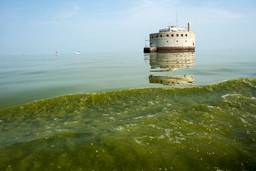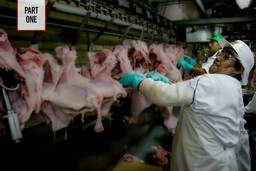The Rio Olympics Are a Reflection of Our Shared Global Crisis
The global tribe will sink or swim together. There is no place to go to escape the pollution and violence.
Laura Orlando

A global spotlight is on Brazil and it is not looking good. The 2016 Summer Olympics begin in Rio de Janeiro this week amid political scandal, social upheaval and environmental catastrophe.
The media’s impulse has been to point a finger at the country and waggle. But as the global tribe gathers, maybe we should take this opportunity to see in Brazil a reflection of us.
Name a country out of the 206 competing that has been spared the convulsions Brazil is experiencing today. Sure, some are in better shape, some worse, but few of the 11,000 athletes are representing a place without economic inequalities or life-threatening pollution. These are shared conditions resulting in global distress.
Competing and living in dirty water
No place tells a better story of how we got into this mess — and how we can get out of it — than Rio de Janeiro and its polluted Guanabara Bay.
Rio de Janeiro is a city of some 6 million people in the southeastern state of Rio de Janeiro. It is protected from the Atlantic Ocean by the Guanabara Bay, which, shaped like an oval, is about 1-mile wide at its mouth to about 15 miles east to west and 19 miles north to south. Its average depth is around 18 feet, but in some areas it is much shallower.
The scenic overlook of the bay, with Rio’s skyline and Sugarloaf Mountain, which juts up like a breached humpback whale, is the stunningly beautiful, postcard image of the place. These days, however, a close-up photograph of the bay is likely to show trash and dead fish. A massive fish die-off in Guanabara Bay in 2014 resulted in 80 tons of dead Brazilian menhaden. The menhaden has been called the most important fish in the ocean. Their health is linked to the ocean’s health.
News stories about dirty water are common as we head into the Games. Pathogenic microorganisms, chemical pollution and eutrophication have degraded the bay’s ecosystem health and threaten its capacity to sustain life.
Rapid urbanization and industrialization are at the root of much of the trouble.
Sixteen million people live around the bay, one of the most industrialized coastal areas in Brazil and home to more than 16,000 industries. Fifty rivers drain into it and most, like Rio Sarapuí, carry wastes from factories and homes. Large amounts of solid waste, organic matter, heavy metals, organic pollutants and hydrocarbons are regularly introduced into the bay by oil refineries, chemical and pharmaceutical companies, textile and food manufacturers, sewage outfall pipes and runoff from dumps. Until it was closed in 2012, Rio had the largest open-air landfill in the world, located on Guanabara Bay. What its infrastructure includes — three seaports, two airports, and two naval bases — is as important as what it does not include — the adequate containment of chemical and biological wastes.
Sewage is a pervasive problem in the bay and its tributaries. This has gotten a lot of attention because 1,400 Olympic athletes will be competing in open water events at three different sites in Rio: Marina da Gloria and Rodrigo de Freitas Lagoon, in Guanabara Bay, and Copacabana beach, on the Atlantic.
The Associated Press commissioned water testing at the three competition sites and one tourist beach, checking for viruses and bacteria. The test results showed that anyone that comes in contact with the water, and, in particular, if they swallow it, is risking their health.
Poor water quality is just a fact of life for Rio’s residents: 65 percent of hospitalizations are due to water-transmitted diseases.
Half of the households in the bay’s basin are not connected to sewage treatment. But if you think sewage treatment is the answer to the bay’s pollution problems, think again. There is no doubt it reduces waterborne diseases caused by microbiological agents like bacteria. Nevertheless, researchers have shown that the frequency of gastrointestinal symptoms climbs the closer one gets to treated municipal wastewater sources.
Moreover, sewers exacerbate water pollution problems by encouraging industrial hook-ups to municipal sewer systems. Sewers are publically-funded drains. The public is fooled into thinking that industrial wastes are “treated,” when in fact sewage treatment, even in the most modern systems in the United States, has nothing to do with mitigating chemicals. The end result is a shell game with the leftovers from modern living — often dangerous to public health and toxic to the environment when put where they don’t belong.
Using water to transport waste material to lakes, bays, rivers and oceans is a global problem. But if end-of-pipe treatment is not the solution, what is? The answer is complex but begins with not mixing waste materials together in the first place. This is exactly the opposite of the reigning sewerage paradigm. Instead, we should recover and recycle as close to the source as possible. Materials with no post-production use or those that are too toxic to render harmless should be banned.
Such an approach is based on a pollution prevention framework. We should leapfrog over multi-billion-dollar wastewater treatment facilities and instead put that money into developing 21st century environmental health solutions in Rio and elsewhere that would be worthy of a gold medal on the global sustainability stage.
Shantytowns and Billionaires’ Row
Several million people — by some estimates half of Rio de Janeiro’s population — live in shantytowns called favelas. Everything about them is unsustainable, yet they stubbornly persist because people need a place to live. Favela residents are overwhelmingly poor and people of color, and their communities reflect both race and class injustices. Like the Earth’s other 650-plus million urban residents who live in slum conditions, they do not have the same degree of protection from health and environmental hazards as their wealthy neighbors, or any say in what those protections should be.
There is an average of 5,000 inhabitants per square kilometer in Rio, but in Rocinha, one of the city’s largest favelas, the density is nearly 10 times that much. Waterborne diseases and the threat of Zika are not the only concerns in these communities. Tuberculosis is rampant.
Violence, another serious public health threat, is also common.
Many of the 206 nations represented in the Olympics have communities in similar circumstances, including the United States, where St. Louis, Baltimore and Detroit all have a higher murder rate than Rio — if one doesn’t count the more than 2,500 people killed by Rio’s security forces since the city was awarded the Olympics in October 2009.
Brazil has one of the highest levels of income inequality in the world. Brazilian developer and billionaire Carlos Fernando de Carvalho, whose company, Carvalho Hosken, S.A., is helping to build Barra Olympic Park and Athletes’ Village, said he wants Ilha Pura, the athletes’ village in Rio, to become “home to a ‘noble’ elite” with gardens that “only kings have previously had” after the 2016 Games.
Yet the growing gap between rich and poor is a global phenomenon, driven by institutions like the European Central Bank and the International Monetary Fund, which are good at measuring inequality while accelerating the conditions that make it so.
Britain’s impending exit from the European Union, a result of a referendum where those without money generally voted to leave and those with money, to stay, has prompted some hand wringing from politicians caught off guard by the vote. Theresa May, Britain’s new Prime Minister, a Margaret Thatcher-admiring Conservative, explained it this way, “There is a growing divide between a more prosperous older generation and a struggling younger generation. And there is a gaping chasm between wealthy London and the rest of the country.”
In the United States, while black men feel their lives are at stake in any confrontation with the police and images of militarized security forces facing unarmed protesters in cities like Baton Rouge travel around the globe, real estate agents worry that New York City’s ultra-luxury real estate boom, with its $100 million price tags, has come to an end. It’s not that the money dried up. The market was flooded with $10 million-plus apartments, so many that Manhattan now has a neighborhood known as Billionaires’ Row.
Sink or swim together
Separation — us and them, nature and me — is the source material for economic inequality and environmental degradation on the mindboggling scale we are witnessing today. Scapegoating “other” and separating ourselves from nature has been the practice of the elites who have benefited from industrialization and who are now in control of the economic and environmental destinies of the global citizenry.
To feel oneself as separate from and without attachment to nature allows for its defilement. If it’s part of you, then what you do to it, you do to yourself. The admiration of its beauty or mechanics without such a connection results in only superficial protections. Call it postcard environmentalism: Look how pretty! (But it’s dying.)
We must learn to hold that beauty at the same time as we hold the environmental catastrophe taking place under the city’s reflection on the water’s edge. This means owning up to the problems and at the same time not letting go of the pleasures of a place and its people. This tension between two very different but co-existing realities creates the energies for action rather than complacency. It helps us fight the despair of environmental degradation while working to clean up our planet.
William Cronon, an environmental historian at the University of Wisconsin — Madison, suggested in his 1995 essay, “The Trouble With Wilderness,” that our romantic ideas of wilderness separated us from nature. When we idealize nature, we stop thinking of ourselves as part of it. Cronon writes:
If wildness can stop being (just) out there and start being (also) in here, if it can start being as humane as it is natural, then perhaps we can get on with the unending task of struggling to live rightly in the world — not just in the garden, not just in the wilderness, but in the home that encompasses them both.
What we see happening in Rio, and in our own cities, is a mirror image of this. We idealize ourselves in relation to the filth and poisons around us. We ignore the fact that no matter how tall the gate at the end of the driveway, or how high the wall between countries, what is coming out of the smoke stacks and sewer outfall pipes is in us. Rio and Guanabara Bay are not (just) over there. They are (also) here, on our planet. The global tribe will sink or swim together. There is no place to go to escape the pollution and violence. It is affecting you as sure as it is the residents of Rocinha.
The old miner’s song, “Which Side Are You On,” was written by Florence Reece in 1931 in Harlan County, Ky., after the police came looking for her husband, a union organizer. The song ends with the line, “Us poor folks haven’t got a chance unless we organize.” Us rich folks haven’t got a chance either, unless we join the poor and together realize ourselves to be living in the same home. Representatives from 206 countries are gathering in Brazil this summer. What a good time to start.








